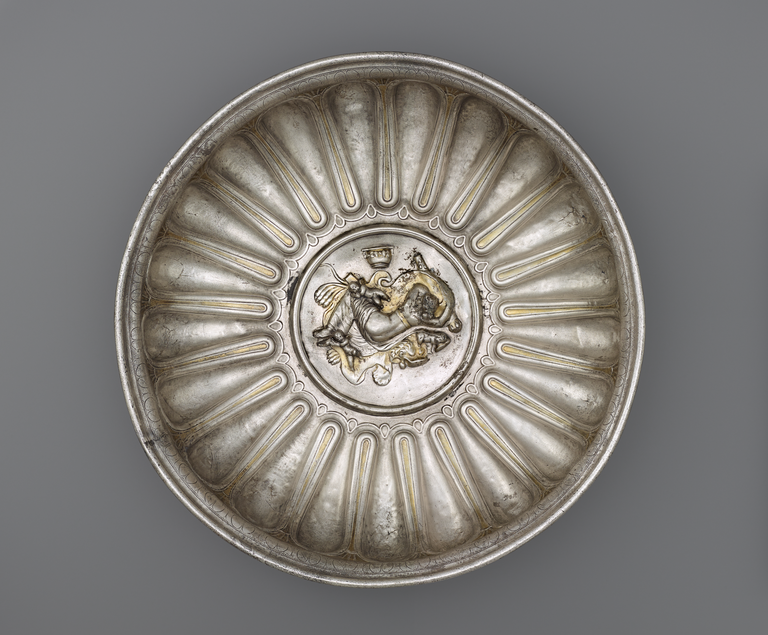Exhibitions: Devotion and Decadence
Devotion and Decadence:
The Berthouville Treasure and Roman Luxury from the Bibliothèque nationale de France
October 17 - January 6, 2019
This article first appeared in ISAW Newsletter 22 (Fall 2018).
 Bowl with a Medallion Depicting Omphale. Roman, 1–100 CE. Findspot: Berthouville, France. Silver and gold. H. 8.2 cm Diam. 28.9 cm. Bibliothèque nationale de France, Paris: inv. 56.11. Inscription: MERCVRIO AVGVSTO Q DOMITIVS TVTVS EX VOTO (To Augustan Mercury, Quintus Domitius Tutus in fulfillment of a vow). Image: Tahnee Cracchiola © Getty-BnF
While plowing a field in 1830 near the village of Berthouville, in rural Normandy, a French farmer unearthed a cache of ancient silver objects. The Berthouville Treasure, as the find has come to be known, is the largest and best-preserved hoard of silver from the ancient world. After news of the discovery was communicated to Paris, the collection of silver and gilt-silver statuettes and vessels—ninety-one silver pieces weighing over fifty pounds in total—were acquired by the Cabinet des médailles et antiques of the Bibliothèque royale (now the Département des Monnaies, médailles et antiques of the Bibliothèque nationale de France) following a bidding war with the Louvre Museum.
Bowl with a Medallion Depicting Omphale. Roman, 1–100 CE. Findspot: Berthouville, France. Silver and gold. H. 8.2 cm Diam. 28.9 cm. Bibliothèque nationale de France, Paris: inv. 56.11. Inscription: MERCVRIO AVGVSTO Q DOMITIVS TVTVS EX VOTO (To Augustan Mercury, Quintus Domitius Tutus in fulfillment of a vow). Image: Tahnee Cracchiola © Getty-BnF
While plowing a field in 1830 near the village of Berthouville, in rural Normandy, a French farmer unearthed a cache of ancient silver objects. The Berthouville Treasure, as the find has come to be known, is the largest and best-preserved hoard of silver from the ancient world. After news of the discovery was communicated to Paris, the collection of silver and gilt-silver statuettes and vessels—ninety-one silver pieces weighing over fifty pounds in total—were acquired by the Cabinet des médailles et antiques of the Bibliothèque royale (now the Département des Monnaies, médailles et antiques of the Bibliothèque nationale de France) following a bidding war with the Louvre Museum.
In the decades that followed, excavations were carried out on the farmland where the farmer unearthed the treasure. These archaeological investigations revealed the foundations of a Gallo-Roman fanum, a theater and temple complex devoted to Mercury Canetonensis, a god particularly revered in the region. Subsequent research at the site clarified successive stages of the sanctuary’s construction and revealed a second temple dedicated to Mercury’s mother Maia or Gallo-Roman consort Rosmerta. It is now believed that the temples were a pilgrimage site, where votive gifts were dedicated to Mercury and his counterpart. Although it is not known when the buildings were destroyed, we do know that the treasure was deliberately buried in the late second or early third century CE.
The Berthouville Treasure includes two striking statuettes of Mercury, around seventy vessels including bowls, cups, pitchers, and plates, as well as separate handles, feet, appliqués, and fragments. Even the earliest studies of these objects revealed that this was a temple treasure, rather than a personal service, as a number of the pieces not only represent Mercury, but also include dedicatory inscriptions to the god. The inscriptions on some of these vessels also tell us something about the diverse people who consecrated them and the operation of the shrine. The Gallic names, Combaromarus and Camulognata, inscribed on a ladle and pitcher respectively, identify their Gallic donors. Other objects were dedicated at the temple by women as well as men, by ex-slaves and the freeborn. Located in an area of ancient pilgrimage and assembly, the collection offers a striking example of the cross-cultural interactions between Roman and indigenous Gallic culture.
Approximately seventy-five other luxury objects from the collections of the Bibliothèque nationale de France including silver platters, cameos, intaglios, coins, and jewelry will join the Berthouville Treasure for this exhibition. In addition to temple dedications, opulent prestige objects also had a lived history as signs of their owner’s wealth, power, and refinement. Devotion and Decadence highlights the significance of Roman luxury arts and their role in both devotional and domestic settings.
Devotion and Decadence: The Berthouville Treasure and Roman Luxury opens on October 17, 2018 and will be on view through January 6, 2019.
This exhibition is made possible by generous support from the Selz Foundation, The Achelis and Bodman Foundation, and the Leon Levy Foundation. Additional funding was provided by Frances Marzio and the Samuel H. Kress Foundation.